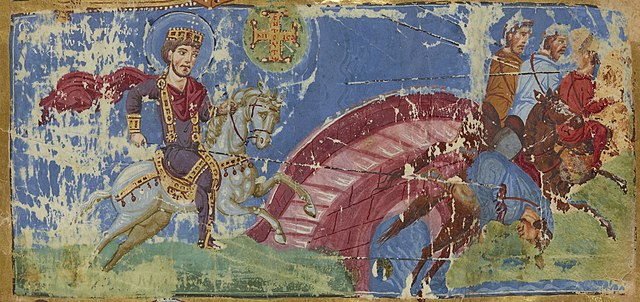Constantine the Great and Christianity
During the reign of the Roman Emperor Constantine the Great, Christianity began to transition to the dominant religion of the Roman Empire. Historians remain uncertain about Constantine's reasons for favoring Christianity, and theologians and historians have often argued about which form of early Christianity he subscribed to. There is no consensus among scholars as to whether he adopted his mother Helena's Christianity in his youth, or, as claimed by Eusebius of Caesarea, encouraged her to convert to the faith he had adopted.
Constantine's vision and the Battle of the Milvian Bridge in a 9th-century Byzantine manuscript.
Jugate gold multiple issued by Constantine at Ticinum in 313, showing the emperor and the god Sol, with Sol also depicted in his quadriga on Constantine's shield.
Follis issued by Constantine at Lugdunum c. 309–310, with Sol holding a globe and wearing a radiant crown. Constantine is described as SOLI INVICTO COMITI, 'Companion of Sol Invictus'
The Emblem of Christ Appearing to Constantine, as imagined by Rubens (1622). Constantine's army sees a chi-rho in the daytime sky.
Constantine I, also known as Constantine the Great, was a Roman emperor from AD 306 to 337 and the first Roman emperor to convert to Christianity. He played a pivotal role in elevating the status of Christianity in Rome, decriminalizing Christian practice and ceasing Christian persecution in a period referred to as the Constantinian shift. This initiated the cessation of the established ancient Roman religion. Constantine is also the originator of the religiopolitical ideology known as Constantinism, which epitomizes the unity of church and state, as opposed to separation of church and state. He founded the city of Constantinople and made it the capital of the Empire, which remained so for over a millenium.
Head of the Colossus of Constantine, Capitoline Museums
Mosaic in the Hagia Sophia, section: Maria as patron saint of Constantinople, detail: donor portrait of Emperor Constantine I with a model of the city
Remains of the luxurious residence palace of Mediana, erected by Constantine I near his birth town of Naissus
Head from a statue of the emperor Diocletian








